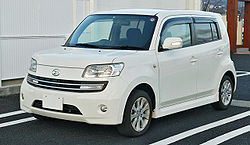This article needs additional citations for verification .(December 2018) |
| Toyota bB | |
|---|---|
 Second generation Toyota bB (2008) | |
| Overview | |
| Manufacturer | Toyota |
| Also called |
|
| Production | January 2000 – May 2016 |
| Body and chassis | |
| Class | Mini MPV |
| Body style |
|
| Layout | Front-engine, front-wheel-drive |
| Chronology | |
| Predecessor |
|
| Successor |
|
The Toyota bB is a mini MPV produced by the Japanese car company Toyota. The first generation launched in 2000, and the second generation was jointly developed with Daihatsu from 2005.
Contents
- First generation (XP30; 2000)
- Engines
- Marketing
- Open Deck (2000–2001)
- Gallery
- Second generation (QNC20; 2005)
- Design
- Body styles
- Engines 2
- Transmissions
- Daihatsu Coo/Materia
- Subaru Dex
- Gallery 2
- See also
- References
- External links
The car has been badge engineered and sold as the Daihatsu Materia, Scion xB and Subaru Dex.












